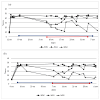Yield and Sensorial and Nutritional Quality of Strawberry (Fragaria × ananassa Duch.) Fruits from Plants Grown Under Different Amounts of Irrigation in Soilless Cultivation
- PMID: 39861639
- PMCID: PMC11769427
- DOI: 10.3390/plants14020286
Yield and Sensorial and Nutritional Quality of Strawberry (Fragaria × ananassa Duch.) Fruits from Plants Grown Under Different Amounts of Irrigation in Soilless Cultivation
Abstract
Water scarcity is an ecological issue affecting over 10% of Europe. It is intensified by rising temperatures, leading to greater evaporation and reduced precipitation. Agriculture has been confirmed as the sector accounting for the highest water consumption globally, and it faces significant challenges relating to drought, impacting crop yields and food security. Sustainable practices, precision irrigation, and the development of drought-resistant crops are essential for the mitigation of this threat. Effective, innovative solutions are crucial for optimizing water use for intensive crops such as cultivated strawberries (Fragaria × ananassa). This study emphasizes the importance of identifying the genotypes most resilient to low water availability. Experimental trials involving reduced irrigation levels were set up to identify genotypes with a greater capacity to increase fruit quality and maintain fruit yield. Reduced water conditions positively influenced strawberry fruit quality, exhibiting improved citric acid, soluble solids, and color brightness linked to decreased water use, while firmness remained stable. Notably, the total phenolic content was most affected by stress, indicating strong antioxidant responses. With these interesting variations in fruit quality came a different response in plant yield. Plants belonging to the Lauretta and AN15,07,53 cultivars maintained a 98% fruit yield when grown under WS1 conditions. While the yield for the Francesca cultivar increased by 10% under the stressed WS1 conditions in comparison to the control conditions, water stress in the WS2 treatment caused a strong reduction in yield in all three genotypes. Overall, the findings emphasize the importance of identifying for each new cultivar the most appropriate water regime in order to amplify the quality of the fruit, thus maintaining high production standards and saving water.
Keywords: Fragaria × ananassa; nutritional quality; soilless; strawberry; water management; yield.
Conflict of interest statement
The authors declare no conflicts of interest.
Figures


References
-
- Patra S.K., Poddar R., Brestic M., Acharjee P.U., Bhattacharya P., Sengupta S., Pal P., Bam N., Biswas B., Barek V., et al. Prospects of Hydrogels in Agriculture for Enhancing Crop and Water Productivity Under Water Deficit Condition. Int. J. Polym. Sci. 2022;2022:4914836. doi: 10.1155/2022/4914836. - DOI
-
- Grant O.M., Johnson A.W., Davies M.J., James C.M., Simpson D.W. Physiological and Morphological Diversity of Cultivated Strawberry (Fragaria × ananassa) in Response to Water Deficit. Environ. Exp. Bot. 2010;68:264–272. doi: 10.1016/j.envexpbot.2010.01.008. - DOI
-
- Lavrnić S., Zapater-Pereyra M., Mancini M.L. Water Scarcity and Wastewater Reuse Standards in Southern Europe: Focus on Agriculture. Water Air Soil Pollut. 2017;228:251. doi: 10.1007/s11270-017-3425-2. - DOI
LinkOut - more resources
Full Text Sources

